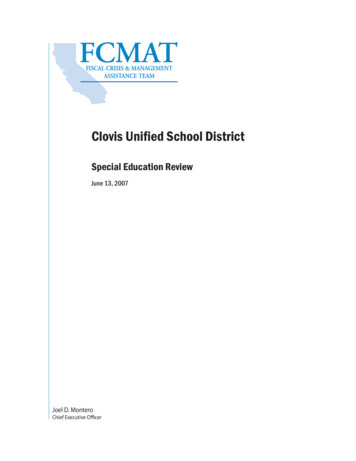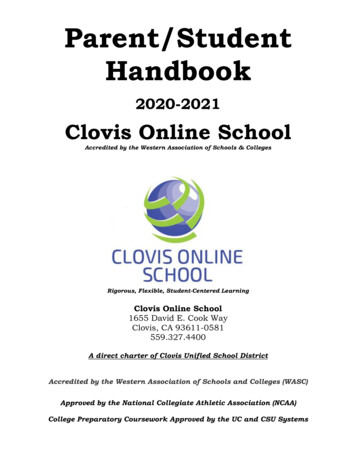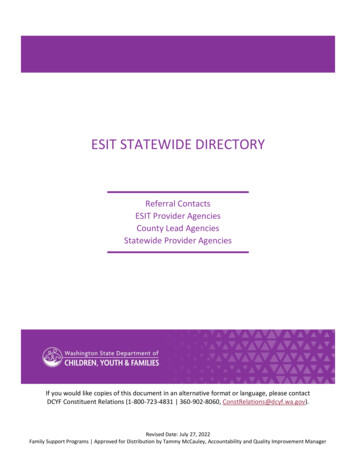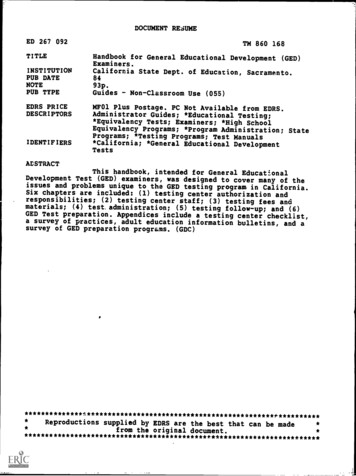
Transcription
Clovis Unified School DistrictSpecial Education ReviewJune 13, 2007Joel D. MonteroChief Executive Officer
Fiscal Crisis & Management Assistance Team
June 13, 2007Dr. Terry Bradley, SuperintendentClovis Unified School District1450 Herndon AvenueClovis, California 93611-0567Dear Superintendent Bradley,In January 2007, the Fiscal Crisis and Management Assistance Team (FCMAT) entered into an agreement fora Special Education review with the Clovis Unified School District. The request specified that FCMAT would:1.2.3.4.5.6.7.8.Review the efficiency and effectiveness of the district’s Special Education fiscal and program delivery system.Review the district process on determining the hiring of one-on-one paraprofessionals andmake recommendations.Review Special Education staffing ratios and the allocation of FTE teachers to student class size.Review the computerized program the district is attempting to implement regarding IEPs.Make recommendations on effectiveness, timeline for implementation, and cost effectiveness compared to other options that may be available.Review interdepartmental processes, including personnel requisition and position control.Review the organizational structure of the Special Education central office managementand clerical staff.Review effective utilization of the current student information system and the CASEMISsystems related to accurate record keeping and decision making tools.Review effectiveness and efficiency of the Special Education budget development andmonitoring process and the interface with the business services department.The attached final report contains the study team’s findings with regard to the above areas of review.We appreciate the opportunity to serve you, and we extend our thanks to all the staff of the ClovisUnified School District.Sincerely,Joel D. Montero,Joel MonteroChief Executive OfficerFCMATJoel D. Montero, Chief Executive Officer1300 17th Street - CITY CENTRE, Bakersfield, CA 93301-4533 Telephone 661-636-4611 Fax 661-636-4647422 Petaluma Blvd North, Suite. C, Petaluma, CA 94952 Telephone: 707-775-2850 Fax: 707-775-2854 www.fcmat.org.Administrative Agent: Larry E. Reider - Office of Kern County Superintendent of Schools.
Fiscal Crisis & Management Assistance Team
TABLE OF CONTENTSTable of ContentsForeword .iiiIntroduction . 1Study Team . 2Study Guidelines . 2Executive Summary . 3Findings and Recommendations . 5Fiscal Effectiveness . 5Program Effectiveness . 7Staffing and Organization .13Computerized IEP and Management Information System . 23Appendices . 27i
FOREWORDForewordFCMAT BackgroundThe Fiscal Crisis and Management Assistance Team (FCMAT) was created by legislationin accordance with Assembly Bill 1200 in 1992 as a service to assist local educationalagencies in complying with fiscal accountability standards.AB 1200 was established from a need to ensure that local educational agencies throughoutCalifornia were adequately prepared to meet and sustain their financial obligations. AB1200 is also a statewide plan for county offices of education and school districts to worktogether on a local level to improve fiscal procedures and accountability standards. Thelegislation expanded the role of the county office in monitoring school districts under certain fiscal constraints to ensure these districts could meet their financial commitments on amultiyear basis. AB 2756 provides specific responsibilities to FCMAT with regard to districts that have received emergency state loans. These include comprehensive assessmentsin five major operational areas and periodic reports that identify the district’s progress onthe improvement plansSince 1992, FCMAT has been engaged to perform more than 600 reviews for local educational agencies, including school districts, county offices of education, charter schoolsand community colleges. Services range from fiscal crisis intervention to managementreview and assistance. FCMAT also provides professional development training. The KernCounty Superintendent of Schools is the administrative agent for FCMAT. The agency isguided under the leadership of Joel D. Montero, Chief Executive Officer, with fundingderived through appropriations in the state budget and a modest fee schedule for charges torequesting agencies.Total Number of Studies. 637Total Number of Districts in CA . 982Management Assistance. 603 (94.66%)Fiscal Crisis/Emergency . 34 (5.34%)Note: Some districts had multiple studies.Districts (7) that have received emergency loans from the state.(Rev. 4/3/07)80Study Agreements by Fiscal Year70Number of Studies605040302010092/93 93/94 94/95 95/96 96/97 97/98 98/99 99/00 00/01 01/02 02/03 03/04 04/05 05/06 06/07ProjectedClovis Unified School Districtiii
Fiscal Crisis & Management Assistance Team
INTRODUCTIONIntroductionThe Clovis Unified School District is located in a fast-growing section of California’sCentral Valley. Its student population resides in the cities of Clovis and Fresno and surrounding areas. Four comprehensive high schools, four middle schools, and 30 elementary schools, plus community day and independent study programs serve students’ educational needs. A seven-member Governing Board oversees district operations.The educational philosophy of the Clovis Unified School District is based on the principlethat “each student shall be given an opportunity to maximize his/her potential in the areasof mind, body and spirit, and become a productive, contributing member of our society.”Toward that end, the district offers a full range of Special Education services, with somespecialized services offered at designated sites.In December 2006, the Fiscal Crisis and Management Assistance Team (FCMAT)received a request from the district for a Special Education review. The scope and objectives of the study agreement between the district and FCMAT are as follows:1. Review the efficiency and effectiveness of the district’s Special Education fiscaland program delivery system.2. Review the district process on determining the hiring of one-on-oneparaprofessionals and make recommendations.3. Review Special Education staffing ratios and the allocation of FTE teachers tostudent class size.4. Review the computerized program the district is attempting to implementregarding IEPs. Make recommendations on effectiveness, time line forimplementation, and cost effectiveness compared to other options that may beavailable.5. Review interdepartmental processes, including personnel requisition and positioncontrol.6. Review the organizational structure of the Special Education central officemanagement and clerical staff.7. Review effective utilization of the current student information system and theCASEMIS system related to accurate record-keeping and decision-making tools.8. Review the effectiveness and efficiency of the Special Education budgetdevelopment and monitoring process and the interface with the Business ServicesDepartment.Clovis Unified School District1
2INTRODUCTIONStudy TeamThe FCMAT study team was composed of the following members:William P. Gillaspie, Ed.D.Management AnalystFiscal Crisis and ManagementAssistance TeamBakersfield, CaliforniaJames “Sarge” KennedyFCMAT Special Education ConsultantRed Bluff, CaliforniaJoAnn Murphy*SELPA Executive DirectorPoway Unified School DistrictPoway, CaliforniaDorothy Kay AtchisonFCMAT Special Education ConsultantAuburn, CaliforniaLaura HaywoodPublic Information SpecialistFiscal Crisis and ManagementAssistance TeamBakersfield, CaliforniaWilliam H. PuddyFCMAT Special Education ConsultantLincoln, California* As a member of the review team, this individual served as a consultant for FCMAT anddid not represent her employer.Study GuidelinesFCMAT consultants visited the district in March 2007 to conduct interviews, collect dataand review documentation. This report is the result of those activities. Findings and recommendations are presented in the following sections: Executive SummaryFiscal EffectivenessProgram EffectivenessStaffing and OrganizationManagement Information SystemFiscal Crisis & Management Assistance Team
EXECUTIVE SUMMARYExecutive SummaryOver the last three years, the effectiveness of the district’s Special Education fiscal management system appears to have been hampered by the lack of a fiscal analyst position.The district elected to revitalize that position in January 2007, and it has been filled.The fiscal analyst will play a very significant role in assisting the Special EducationDepartment to function within the parameters of the program budget. It appears that thefiscal analyst will facilitate effective budget supervision and regularly convey the fiscalstatus of the program to department administrators.The district appropriately utilizes the SACS coding system for its Special Education program except that there seems to be some confusion with regard to “regionalized services”(SACS Goal 5050) and “regionalized program specialist services” (SACS Goal 5060).The district needs to clarify the differences between these two areas. The district mightalso consider making use of appropriate subgoals to monitor expenditures for a givenpopulation or service.The district takes pride in its efficient and effective educational system for all studentsand has developed unique educational service models for both general and SpecialEducation. Many of the district’s schools are identifying non-performing students andemploying alternatives before referring students to Special Education. This has resultedin an identification rate of 7.59%, much lower than the statewide rate of 10.82%. Thedistrict has made a major effort to provide alternative educational programs and reducethe number of students served in the mild to moderate disabilities categories, particularlyspecific learning disabilities and speech and language disorders. The notable exception isstudents with other health impairments.Significant increases have occurred in the numbers of students with low incidence disabilities (vision, hearing, and orthopedic impairments) and with autism spectrum disorder.This reflects statewide and nationwide trends. These students require intensive servicesand very low pupil-to-staff ratios.The efficient and effective delivery of Special Education programs depends in large parton coordination with other district services. Areas that the district might address to furtherimprove Special Education program delivery are technology, professional development,and curricular alignment. These should be cooperatively reviewed and revised with theappropriate departments.The greatest portion of fees for legal services in 2005-2006, 264,195, was for telephoneconsultations. It is quite probable that other SELPAs have had similar situations and couldprovide effective strategies for avoiding such a large accrual of legal fees. To deter litigationagainst the district and reduce the numbers of more difficult cases, and/or the reliance onlegal consultation, ongoing professional development must be provided to all staff.Clovis Unified School District3
4EXECUTIVE SUMMARYThe role of the Program Specialist appears to combine the regionalized duties associatedwith such a position plus an extensive coordination/supervisory role. The district shouldconsider reviewing these positions and their responsibilities.Many school sites have fully embraced their students with disabilities and consider themfull members of their school communities. Some schools, however, need more trainingand encouragement to replicate this attitude.The district receives a very high level of support from parents of students with disabilitiesand has an excellent reputation.The district provides a rich educational program and service environment for studentsby implementing smaller than traditional caseloads and providing appropriate levels ofsupport staff. However, the use and supervision of instructional paraprofessionals needsreview and revision, particularly with regard to one-on-one paraprofessionals.The district lacks an electronic Individualized Education Program (IEP) template. Thus,information from the IEP is not promptly entered into the CASEMIS database. The current CASEMIS system is cumbersome, outdated, does not generate useful and timelyinformation, and has resulted in late reports to the state. The CASEMIS requirementshave become far more sophisticated over the last decade and should be handled by atechnology analyst. The district should explore implementing a computerized IEP system,even if that means replacing Zangle, which the district now uses for Special Educationdata reporting.The current structure of the Special Education Department and its interactions withother key departments should be reviewed and plans developed to improve collaborationamong all the departments. Special Education should be structured so that it can expandas district enrollment increases over the next decade, yet remain responsive to students’needs.Fiscal Crisis & Management Assistance Team
FISCAL EFFECTIVENESSFiscal EffectivenessFiscal AnalystOver the last three years, the effectiveness of the district’s Special Education fiscal management appears to have been hampered by the absence of a fiscal analyst position, whichwas eliminated by necessary budget reductions. This position provides a necessary interface between the district’s Business Department and the Special Education Departmentfor the day-to-day implementation of its Special Education budget. In January 2007, thedistrict elected to revitalize the position, which has been filled. The district has directedthe analyst to begin working in the Business Department to facilitate understanding itsroles, functions, responsibilities, and expectations. The analyst will play a very significantrole in assisting the Special Education Department to function within the fiscal parameters of the program’s budget.The staffs of the Business and Special Education departments appear optimistic that reactivating the fiscal analyst position will yield significant improvements. The fiscal analystand the Business Department staff state that they are already preparing to develop the2007-08 budget. This suggests that the process of budget development will be cooperative, and the resulting budget may well produce a more accurate fiscal blueprint for theSpecial Education Department’s programs and services.It appears that the fiscal analyst will facilitate effective budget supervision and will regularly convey the fiscal status of the program to department administrators.The district has scheduled the fiscal analyst to spend significant time for the first coupleof months in the Business Department, which will enable a better grasp and understanding of the department’s procedures, practices, and expectations. This bodes well for agreatly improved relationship between the Special Education and Business departments.Given the interwoven nature of Special Education, Business, and Human Resources,the district should strongly consider having the fiscal analyst spend time in the HumanResources Department as well. The position is structured to play a key role in business,personnel, and program operations and could contribute greatly to effective working relationships among these departments.RecommendationsThe district should:1. Allow a reasonable learning curve for the fiscal analyst to develop knowledge andexperience in the position’s duties and in interacting with other departments.2. Provide the fiscal analyst the opportunity to work in the Human ResourcesDepartment to become fully familiarized with its procedures, practices andexpectations as they relate to Special Education.Clovis Unified School District5
6FISCAL EFFECTIVENESSBudget DevelopmentA collaborative process for developing the 2007-08 Special Education budget has alreadybegun and should result in a much more accurate and useful budget.The budget generally uses appropriate SACS codes for Special Education accounting.However, there seems to be a lack of clarity with regard to “regionalized services” (Goal5050) and “regionalized program specialist services” (Goal 5060).Regionalized services may include regionalized program specialist services, but thereverse is not true. For example, Goal 5050 may include regionalized program specialistservices, but Goal 5060 should not include other regionalized services.While the district employs the term “program specialist” as a specific job title, most ofthe duties appear to be program coordination or supervision rather than typical programspecialist activities.The district uses the basic SACS goal codes, but does not use optional subgoal codes totrack certain types of Special Education expenditures. For example, Goal 5750 is used forservices to students with severe disabilities or low incidence disabilities. Using optionalsubgoal code 5760-769, the district could monitor the expenditures for low-incidencedisabilities. Similarly, the district could monitor expenditures for particular services orfor services to specific populations, such as autistic or emotionally disturbed students, byusing other goal or function subcodes.The district uses an Allocated Personnel Unit (APU) system to determine staffing needsand staffing levels at school sites or in specific programs, but there does not appear to besuch a system in use for Special Education. The monitoring of staffing needs, particularlyfor the classified instructional staff, is cumbersome and inefficient. There is often a longlag between opening an instructional assistant position and filling that position.RecommendationsThe district should:1. Clarify that expenditures are appropriately charged to SACS Goal Codes 5050and 5060. Refer to Education Code Section 56836.23, which is attached inAppendix A to this report.2. Review a list of proposed optional subcodes for SACS goal and function codesand determine whether using specific code options would provide the district withmeaningful and useful information.3. Adapt the staffing system for use with Special Education personnel or develop aposition control system for use in staffing and budgeting positions in this program.Fiscal Crisis & Management Assistance Team
PROGRAM EFFECTIVENESSProgram EffectivenessHistorical DataClovis Unified School District has developed unique educational service models in bothgeneral and Special Education. Many district schools try several alternatives with nonperforming students before referring them to Special Education. This has helped reduceidentification rates to levels much lower than the statewide averages.Special Education Pupil Count Data(1062117 Clovis Unified)Special Education Pupil CountYEARCBEDSDist Svc% /-Dist Res% 442,8618.09%2,8858.16%% /-1.96%-2.42%2005-200636,3782,874% /-2.93%0.45%2006-200737,0412,812% /-1.82%-2.16%2003-2007 chg.6.86%-4.09%-4.50%7.90%2,8977.96%0.42%7.59% Data not availableThe historical pupil count data indicates a steady decline in the number of studentsrequiring Special Education services. The district’s Special Education pupil count enrollment (2006-07) of 7.59% is well below the state average of 10.82% (2005-06 pupil countand CBEDS data).While the district’s CBEDS enrollment has increased 6.86% from 2003-04 to 2006-07,the Special Education pupil count has decreased by 4.09%. This reflects district efforts toprovide alternative educational programs and reduce the number of students served in theMild to Moderate Disabilities categories.Clovis Unified School District7
8PROGRAM EFFECTIVENESSMild to Moderate 2,4262004-20059512071,1542,312% % /-0.00%8.70%-5.20%-1.82%2006-20079072759962,178% /--4.63%22.22%-8.96%-4.05%4-Year % Change-6.11%40.31%-21.20%-10.22%4-Year Changein No. of Students-5979-268-248The district has had a significant reduction in Severe Learning Disabilities and a smallerdecrease in Speech and Language Impaired. Other Health Impaired shows a steep increase.This may affect the duties and workload of the district’s health services personnel.Low Incidence 532691452004-20053893069146% % 4% /-4.65%30.00%30.56%-9.23%6.49%4-Year % Change15.38%160.00%46.88%-14.49%13.10%4-Year Changein No. of Students6815-1019There is a significant increase in low incidence disabilities service requirements. In thepast three years the Hard of Hearing, Deaf and Visually Impaired categories have had significant growth. The new requirements and standards for sign language interpreters maysignificantly affect the district’s budget.Fiscal Crisis & Management Assistance Team
PROGRAM EFFECTIVENESS9Moderate to Severe 3-2004189762081133612004-200520876639416403% 2006228789311616450% 25827413616470% /--1.32%5.13%-22.22%33.33%17.24%0.00%4.44%4-Year % -Year Changein No. of Students36654553109There has been significant growth in the autism population. Many of these studentsrequire intensive services and small pupil-to-staff ratios and could significantly affect thedistrict’s budget.Professional DevelopmentThe Special Education Department and Curriculum Services and Innovations Departmentshould collaborate on an ongoing professional development plan. Professional development is the backbone of effective and efficient programs and promotes good curriculumand instruction.To provide effective professional development, a needs assessment should be conducted annually for general education staff, Special Education staff and parents. Theneeds assessment should be available in English and Spanish. The Special EducationDepartment at Napa Valley Unified School District has developed a needs assessment thatasks staff and parents if they are interested in professional development in areas such asbehavior intervention and improving math and reading skills.Other research-based professional development activities must be provided in SpecialEducation to help guide instruction. This is particularly true with regard to autism as thatstudent population continues to increase.Each training activity should include a data sheet containing the following information: costof the training, budget category, names or numbers of people receiving the training, location of training, a copy of the flier announcing the program, a summary of the evaluations,and other information deemed necessary. This file should be maintained by clerical supportstaff. It will provide a professional development history and allow the district to more accurately report these activities to the California Department of Education. It will provide evidence of training in due process activities, and assist in professional development planning.Clovis Unified School District
10PROGRAM EFFECTIVENESSLitigationThe increase in litigation under the Individuals with Disabilities Education Act has hada significant impact on time and resources in districts across the state. The federal lawprovides the procedural safeguards to parents to ensure that their students receive a freeappropriate public education and offers the opportunity to appeal their case should adispute arise. During the last quarter of 2006 there were 657 requests for due processhearings across the state, with 170 of those cases involving students with autism. Duringthat same time frame, Clovis had two cases filed, with a total of three this year to date.Litigation is costly for the district and time intensive for the district Special Educationadministration, which can negatively affect the effective management of departmentoperations.To deter litigation against the district, reduce the numbers of more difficult cases, and/orreduce the reliance on legal consultation, ongoing professional development should beprovided to all staff and parents. During 2005-06, the Special Education Departmentaccumulated legal fees of 264,195. The greatest portion of those fees was for telephoneconsultations with law firms to try to resolve Special Education issues with parents at anearly stage in the process. It is quite probable that other SELPAs have had similar situations and could provide strategies to reduce the need for legal counsel, thus avoiding theaccrual of legal fees.FCMAT found no indication that the district had an ongoing system for keeping siteadministrators and key special and general education staff updated on ever-emergingcompliance issues that derive from court decisions, fair hearing rulings, and statutorychanges. This leaves the staff open to inadvertently initiating reactions that could lead tolitigation.A a number of staff members have received training in the facilitated IEP process andother alternative dispute resolution practices. These skills should continue to be used onan ongoing basis as a means of reducing the potential for acrimonious disagreements.RecommendationsThe district should:1. Develop an annual Special Education needs assessment for parents and SpecialEducation staff.2. Form a Professional Development Committee consisting of Special Educationstaff, general education staff and parents to review the needs assessment data anddevelop a two-year professional development plan.3. Provide ongoing training on IEP compliance to administrators, and to the generaleducation and Special Education staffs.Fiscal Crisis & Management Assistance Team
PROGRAM EFFECTIVENESS4. Identify an Assistant Director of Special Education to be responsible forprofessional development and collaboration with the Curriculum Services andInnovations Department.5. Develop a standard evaluation form for all professional development activities.6. Annually develop and post a professional development calendar on the district’sWeb site, making it more accessible for professionals and parents.7. Continue to annually set aside funds for professional development and training.8. Develop a dispute prevention plan and ensure that program specialists andassistant directors have skills and training in working with litigious situations.9. Have the SELPA Director and the Associate Superintendent, Curriculum Servicesand Innovations Department, provide a list of professional training activities foreach month and post the activities on the district’s Web site.Site Roles in Special EducationMost of the district’s schools assume full responsibility for the Special Education programson their site as part of the district’s decentralized culture. However, some sites have notfully folded Special Education into that culture. This places Special Education somewherebetween centralized and decentralized supervision. The lack of clarity in direction andcoordination produces confusion as to who is responsible for Special Education programsand services at some school sites. Time and attention need to be allocated specifically toensure that all school sites understand the decentralized system and take full ownership ofall programs serving their student community. Leadership must be provided in supportingall school programs, including Special Education. This may include coaching programsfor principals and assistant principals, as well as training for office assistants and managersregarding Special Education and the importance of inclusion.RecommendationsThe district should:1. Have area assistant superintendents and the SELPA Director develop action plansto address site roles in Special Education.2. Develop a support system to ensure that all schools embrace and operate inclusiveand effective Special Education programs.3. Provide training for Special Education staff regarding their roles on campus andthe importance of communication and cooperation with the general educationcommunity.4. Develop a general education teacher support system on each campus so that theteachers feel more comfortable working with students with severe disabilities.Clovis Unified School District11
12PROGRAM EFFECTIVENESSParent RelationshipsThe district’s parents are very supportive and proud of the Special Education programsoffered. Parents were very interested in bringing back many of the Special Educationprograms operated previously by Fresno County Office of Education. This transition hasoccurred and has resulted in site and community ownership of students, programs andservices. Many of these programs include medically fragile students.The Community Advisory Committee (CAC) is a very active organization and providessupport as well as ongoing parent education. The committee is also involved in studentrecognition programs that are visible throughout the district. The district actively supportsthe
Clovis Unifi ed School District Special Education Review June 13, 2007. Fiscal Crisis & Management Assistance Team. FCMAT Joel D. Montero, Chief Executive Officer 1300 17th Street - CITY CENTRE, Bakersfield, CA 93301-4533 . Telephone 661-636-4611 . Fax 661-636-4647 422 Petaluma Blvd North, Suite. C, Petaluma, CA 94952










